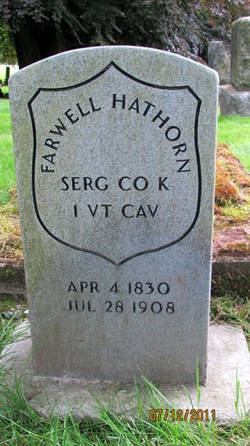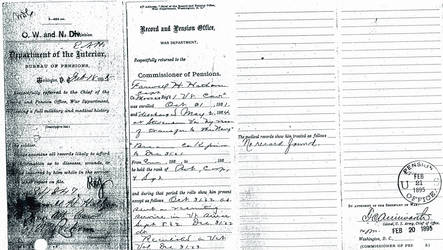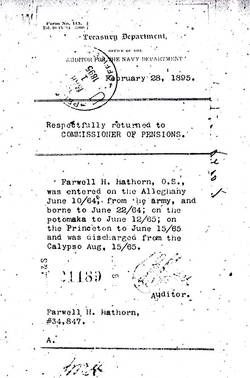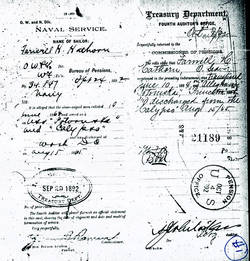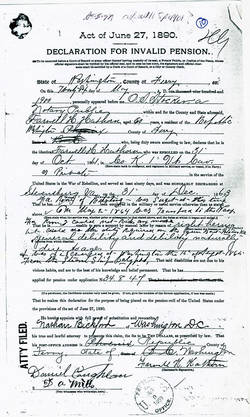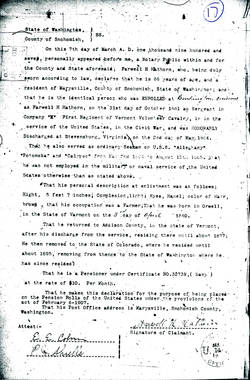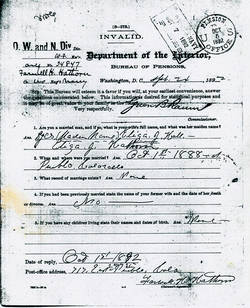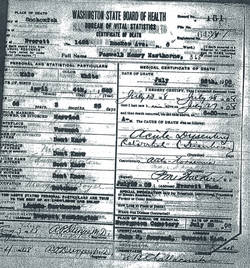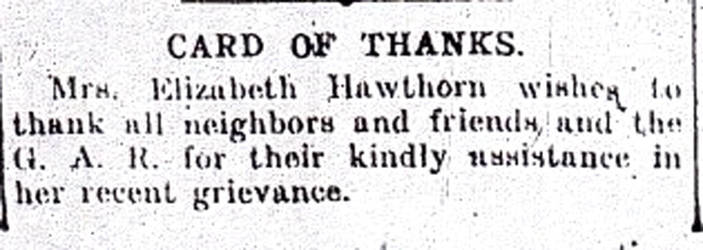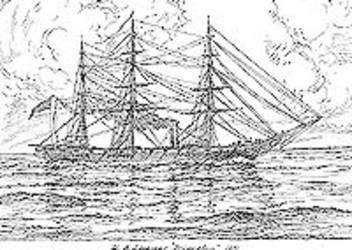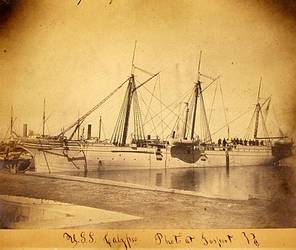H. Farwell "Fred" Hathorn
Representing: Union
G.A.R Post
- John Buford Post #89 Everett, Snohomish Co. WA
Unit History
- 1st Vermont Cavalry H
Full Unit History
1st VERMONT VOLUNTEER CAVALRY
Organized: 11/1/61 Burlington, VT
Mustered In: 11/9/61 Burlington, VT
Mustered Out: 8/9/65
U.S.S. ALLEGHENY
Commissioned: 2/22/47 Pittsburg, PA
De-commissioned: Inf. Not. Avail.
U.S.S.POTOMSKA
Commissioned: 12/20/61 New York Naval Yard, New York, NY
De-Commissioned: 6/16/65 Philadelphia, PA
U.S.S. PRINCETON
Commissioned: 5/18/52 Boston, MA
Decommissioned: 1866
U.S.S. CALYPSO
Commissioned: 9/24/63
De-Commissioned: 8/15/65 Washington Naval Yard, Washington D.C.
Regimental History
REGIMENTAL HISTORY:
The 1st, a three-year "eastern theater" cavalry regiment left Vermont for Washington City on 12/14/61. It first met the enemy in Virginia's Shenandoah Valley on 4/16/62 charging through the village of Mt. Jackson and driving Ashby Turner's Confederate horsemen for more than a mile. By May, however, the unit was retreating northward down the valley with other Federal forces. Actions during this withdrawal included, McGaheysville, Middleton and Winchester.
During the summer '62 campaign with Union Gen. John Pope which culminated in the late August Union defeat at the 2nd Bull Run/Manassas, the regiment was constantly on the move. As a result, when the campaign ended its ranks were so reduced in numbers that it was pulled from the field and assigned to the defenses of Washington.
The winter of '62/'63 was spent replenishing ranks while portions of the unit contended with Confed. John Mosby's forces in northern, VA. For the most part these actions were bloodless, but on 4/1/63 an attempt to capture "The Gray Ghost" resulted in a serious blow to the regiment as a captain, a lieutenant and seven enlisted men were killed or mortally wounded, twenty-two men wounded and eighty-two men and ninety-five horses captured. This defeat was at least partially redeemed at the end of May when the 1st completed routed Moseby's forces near Greenwich, VA.
Early July found the unit in action at Gettysburg, PA where, during a disastrous charge behind enemy lines initiated by Union cavalry general "Kill Cavalry" Kilpatrick, Brig. Gen. Elon J. Farnsworth was left dead on the field, the only general officer to be killed during those bloody three days of fighting.
Winter 1863/1864 found the 1st stationed at Stevensburg, VA. From there it engaged in picket duty along the Rapidan River as well as participated in Gen. Kilpatrick's raid on Richmond in an abortive attempt to free Union prisoners from Libby Prison.
May, 1864 found the 1st moving southward with the Union Gen. U.S. Grant in the Overland Campaign, which would ultimately lead to the end of four years of bitter civil war. During that campaign's opening battle at the Wilderness the regiment lost heavily in killed and prisoners. Engagements at Yellow Tavern and Meadow Bridge then preceded additional actions at Hanover Ct. House, Ashland and Hawe's shop.
After Federal forces crossed the James River the regiment was part of a large Union force sent to destroy the Weldon, Southside and other railroads supplying Richmond. For seven days the unit was constantly skirmishing while destroying Rebel railroad property. Considerable losses were suffered during this period.
August, 1864 found the 1st bound for Washington, D.C. enroute to returning to the Shenandoah Valley with Union Gen. Phil Sheridan. Actions that followed completely cleared the Valley, known as the "Breadbasket of the Confederacy," of Rebel forces.
1865. February of the New Year saw the 1st return to the Richmond/Petersburg, VA area. There, on 4/1/65 it was actively involved in the Battle of Five Forks which broke the long Union/Confederate stalemate and led, on 4/9 to the surrender of Confed. Gen. R.E. Lee’s Army of Northern Virginia to U.S. Grant. For the 1st, the war was over.
As of final muster in August, 1865 the 1st had participated in seventy-five battles and skirmishes while achieving the reputation of the one of the best fighting regiments in the Union. For this, it achieved the status of standing fifth in the list of cavalry organizations suffering greatest in terms of killed and mortally wounded.
VESSEL HISTORY: (Allegheny)
The Allegheny was an iron-hulled steam gunboat propelled by two horizontal paddle wheels. Her keel was laid down in Pittsburg, PA sometime prior to 11/11/44. She was launched and commissioned on 2/22/47.
Allegheny’s initial assignments were along the coast of South America, but engine problems caused her to be re-assigned to the Gulf of Mexico before being placed into ordinary (mothballs) in 1849. She remained there until 1851 when her paddle wheels were replaced with a screw, but despite the modification, she failed to pass sea trials and was returned to ordinary.
In 1856 Allegheny was fitted for service as a receiving ship, the navy's version of a floating induction center. Moved to Baltimore, MD, she was there when the Civil War broke out in April, 1861. Due to the unstable situation around Baltimore during the early days of The Rebellion, Allegheny was towed across the harbor and moored under the safety of the guns of the Union's Ft. McHenry before, in early May, being moved anew to Annapolis, MD to help protect the city which had become the chief embarkation point for troops sent from the north to defend Washington, D.C.
Allegheny remained at Annapolis until late in 1861 when conditions in Maryland had stabilized to a point where she resumed her primary duty as a receiving ship. She continued in that service throughout the remainder of the War.
In 1868 Allegheny was moved to Norfolk, VA. There on 5/15/69 she was sold at auction. No record of her subsequent career/fate has been found.
VESSEL HISTORY: (Potomska)
Potomska was a wooden screw steamer rigged as a three masted schooner. She was purchased by the U.S. Government at New York City on 9/25/61 and first commissioned that December. Throughout her wartime career Potomska was de-commissioned/re-commissioned two times before and after repairs.
While in active service with the U.S. Navy Potomska was assigned to the South Atlantic Blockading Squadron along the southeast coast of the Confederacy. While there she was continually active assisting Federal army operations along the coast and in tidewater rivers, often being under fire from enemy shore troops. On one occasion, February 23, 1863 she captured a British blockade runner loaded with a cargo of coffee and salt destined for the Confederacy.
The War over, on June 1, 1865 Potomska steamed northward from South Carolina. She was decommissioned for the final time on 6/6/65. After being sold at auction in Philadelphia, PA on 8/10/65 her history and fate is not known.
VESSEL HISTORY: (Princeton)
The hull of the Civil War-era Princeton, a clipper-built ship, was laid down at the Boston, MA Navy Yard in June, 1851. Utilized in the construction were some timbers from her earlier namesake. Upon completion of the hull she proceeded to Baltimore, MD where new boilers and propellers were added to her Ericsson-semi-cylinder engines.
In November, 1852 Princeton was fitted for duty with U.S. Commodore Perry's Squadron in the Far East, but never made it beyond Chesapeake Bay in MA because of boiler troubles. Shortly thereafter she was de-commissioned.
From July to September, 1853, after re-commissioning, Princeton served as the flagship of the Eastern Squadron responsible for protecting fisheries off the coast of Nova Scotia, Canada. Duty in the Gulf of Mexico and the West Indies followed before she returned to Norfolk, VA on 6/10/55 and was placed into mothballs, then known as "ordinary."
In 1857 Princeton was taken to Philadelphia where she was moored and served as a receiving ship, the Navy equivalent of a floating induction center, throughout the American Civil War. After being taken out of service, she was sold on 10/9/66. Her usage and fate from that time onward is not known.
VESSEL HISTORY: (Calypso)
The American Civil War-era Calypso was an armed three masted steamer that was captured from the Confederacy on 6/11/63 off Wilmington, NC. She was subsequently commissioned into the U.S. Navy on 9/24 of the same year.
Following her commissioning, Princeton joined the Union's North Atlantic Blockading Squadron off Wilmington, NC and on 10/24 took her first "prize", the schooner Herald. Repairs in Norfolk, VA came the following month.
In March, 1864 Calypso was back on duty off Wilmington where she assisted in supporting an expedition into New River Inlet to land Federal troops whose goal was to destroy the Wilmington and Weldon Railroad. After the troops were successfully landed Calypso's boats patrolled up the river and carried supplies to the army. When Confederate forces prevented linkup of the landing party with a Federal force moving overland, Calypso swiftly evacuated the soldiers.
Throughout the summer of 1864 Calypso tracked ships sailing out of Nassau, in the Bahamas Island who were attempting to "run" the Union blockade in order to deliver supplies to the Confederacy. On 10/28, after a long chase, Calypso, with the aid of other U.S. ships captured the steamer Lady Sterling.
Sent north with the Lady Sterling, Calypso underwent repairs before returning south in the late spring of 1865 to cruise the waters from Chesapeake Bay to Florida.
After being de-commissioned on 8/15/65 Calypso was moved to New York where she was sold on 11/30/65. Her final fate is not known.
Soldier History
SOLDIER:
Residence: Bridgeport, VT Age: 20.6 or 21.6 yrs.
Enlisted/Enrolled: 10/31/61 Bridgeport or Burlington, VT. Rank: Pvt.
Transferred Out: 5/2/64 to U.S. Navy
Highest Rank: Sgt.
SAILOR: (Allegheny)
Residence: Bridgeport, VT (est.) Age: 23.2 or 24.2 yrs.
Transferred In: 6/10/64 Rank: Ordinary Seaman
Transferred Out: 6/22/64
Highest Rank: Ordinary Seaman
SAILOR: (Potomska)
Residence: Bridgeport, VT (est.) Age: 23.2 or 24.2 yrs.
Transferred In: 6/22/64 Rank: Ordinary Seaman
Transferred Out: 6/12/65
Highest Rank: Ordinary Seaman
SAILOR: (Princeton)
Residence: Bridgeport, VT (est.) Age: 24.2 or 25.2 yrs.
Transferred In: 6/12/65 Rank: Ordinary Seaman
Transferred Out: 6/15/65
Highest Rank: Ordinary Seaman
SAILOR: (Calypso)
Residence: Bridgeport, VT (est.) Age: 24.2 or 25.2 yrs.
Transferred In: 6/5/65 Rank: Ordinary Seaman
Discharged: 8/15/65 Washington, D.C.
Highest Rank: Ordinary Seaman
Family History
PERSONAL/FAMILY HISTORY:
Henry Farwell Hathorn was born in Orwell, Vermont on the third of April of either 1840 or '41 to parents Henry C. (b. 1802/'03 VT), a farmer and Abriana/Abrina (b. 1807 no nee, VT) Hathorn. He was one of at least seven children. His known older siblings were: William Wallace (b. 1833 VT), Francis (b. 1836 VT) and Rhoda (b. 1839 VT). He had two younger sisters: Mary A. (b. 1842 VT) and Martha E. (b. 1847) as well as one younger brother: Horation M. (b. 1847 VT). Nothing is known about his childhood, formative or early teenaged years other than his family, in 1850 were residing in Ferrisburg, Addison County, VT and in 1860 they were in or near the Addison County community of Bridgeport.
On 10/31/61 5'7", light-complexioned, hazel-eyed, brown-haired farmer H. Farwell Hathorn joined the U.S. Cavalry. The following May 25th near Williamsport, MD during the retreat of Federal forces under Union Gen. Banks northward out of Virginia's Shenandoah Valley trooper Hathorn suffered a ruptured right testicle from contact with his saddle pommel. Also, along in here he was promoted from private to corporal and then, from corporal to sergeant.
In early September, 1862, likely at least partially because of his injury, Sergeant Hathorn was pulled from active field service and sent back to Vermont on recruiting duty. He did not return to his regiment until December 31st.
Late 1863 found sergeant Hathorn re-enlisting as a veteran volunteer trooper, but by 5/2/64 his testicle rupture was such that he could not longer ride. As such, on the advice of a surgeon, he transferred to the U.S. Navy where he was considered suitable to perform miscellaneous work aboard gunboats. While generally individuals with no shipboard experience entered the navy as a "landsman" before being trained as a seaman, available documentation indicates Farwell transferred in as an "ordinary seaman." If this is true, perhaps he was granted promotional credit because of his successful service and subsequent rank in the cavalry. He was to remain in the Navy until discharged from the service in August, 1865. Also, the transfer to the navy may have resulted in his name being recorded as Farwell H. Hathorn.
The War and military service behind him, Mr. Hathorn returned to Vermont where he settled in or near the community of Auburn. There he likely returned to a life of farming.
Somewhere between 1865 and 1868 it appears H. Farwell apparently married to Martha Nelson (b. ca. 1845). Likely the marriage took place in Vermont as it was there the couple was residing in the community of Orwell during the 1870 U.S. Census. The union appears to have produced four children- Lucy Alice (b. ca. 6/69 VT), Fred (b. 1873 VT), Ella M. (b. 8/1875 or 1876 VT) and Joseph P. (b. 6/1879/'80) - before falling apart.
Following Ella's 1876 birth matters become clouded pertaining to Farwell's and Martha's relationship. While their last child Joseph, was born in 1879 in Vermont, available documents hint that one or both parents may have moved westward to Pueblo, CO as early as 1877.Does this mean Farwell went west on his own, but returned to Vermont to sire his final child? We may never know. However, by 1880 it is clear he was living in Trego County, KS, apparently alone and without an occupation while Martha, noted as married, along with her four children was residing with her parents in Shoreham, Addison County, VT.
In 1888 Farwell's story takes an even more interesting turn on 10/1 of that year in Pueblo, CO he reportedly "married" Elizabeth "Eliza" J. Hall. At the time he did not seem to disclose that he was already married and, later, would indicate no record of the second marriage existed...................
While no 1890 census data is available due to loss by fire, on 2/29/92 while still in Pueblo, former Civil War soldier H. Farwell Hathorn applied for a U.S, Government disability pension based on nasal catarrh (infection), disease of the throat, kidneys and his injured testicle all of which he traced to his period of service. The request was apparently rejected as it was again, in May, 1894. There was supposedly no ratable connection to his period of military service for the testicle injury, catarrh, and disease of throat or kidneys.
At some point during or after February, 1895 the Hathorns departed Colorado for Washington State. Why the move was made is not known, but initial settlement appears may have been in Ferry County in the far eastern part of the state. While neither Farwell nor Eliza can be found in the 1900 Washington State Census, May of that same year placed them in that county when Farwell once again applied for a disability pension based on general debility due to age. That same year the census for Shoreham Twp. Addison Co. VT noted Martha, now divorced, supposedly having had two children, both of whom were still living. With her in the home were children, Joseph, Ella and her husband, Plin Waite. After that, Martha's whereabouts are unknown.
In October, 1901 Farwell was still in Ferry County claiming kidney troubles, heart problems and rheumatism. Also, for the previous fifteen years he had been unable to work due to the rheumatism and sugar in his urine. The plea for a pension again went unanswered then as well as in August, 1903 because there was no evidence the underlying injuries had been suffered in the line of duty.
March, 1907. Farwell and, apparently, Eliza had moved westward across Washington and were supposedly residing in the Snohomish County community of Marysville. However, a directory for the City of Everett, located slightly south of Marysville, during the same year noted Farwell H. Hawthorn residing at 1422 Rucker Avenue in Everett. There is, however, no mention of a wife .Interestingly, by this time he was receiving a $10 per month government stipend, perhaps because all "old soldiers" were, by then receiving some support for having served their county during its hours of internal crisis.
H. Farwell Hathorn died 7/28/08 of acute dysentery with auto toxemia (high level of toxins in the intestines) contributing. Notification of his passing was from Elizabeth Hawthorn and her Everett address was the same as Farwell’s.
H. Farwell Hathorn was buried in Everett's Evergreen Cemetery. While there was not an obituary printed for him in the local newspaper, later, there was a thank you from Mrs. Elizabeth Hawthorn thanking the local G.A.R. post for their participation in the internment and for providing a headstone for his gravesite.
At death former Civil War cavalryman H. Farwell Hathorn was receiving a $12 government pension. However, there is no available documentation indicating Elizabeth ever requested or, if so, received a portion of that monthly stipend. Perhaps the two were never legally married. When Elizabeth died and where she is buried is not known.
Cemetery
Buried at Evergreen Cemetery Everett
Row: 15
Site: 369
Adopt-a-Vet Sponsor
Stewart Tedford
Woodinville, WA
